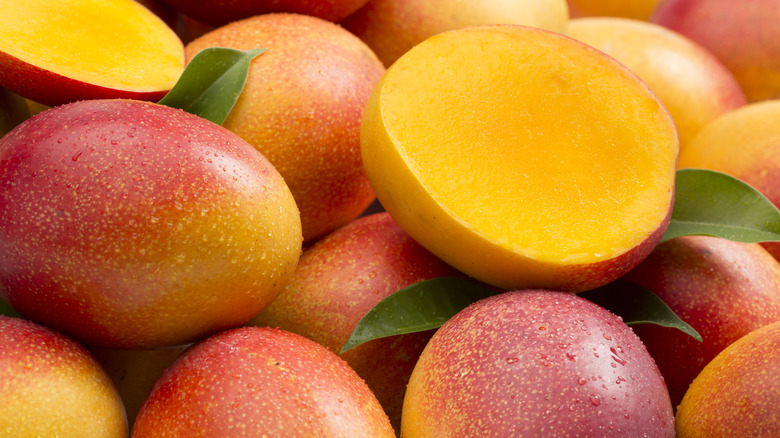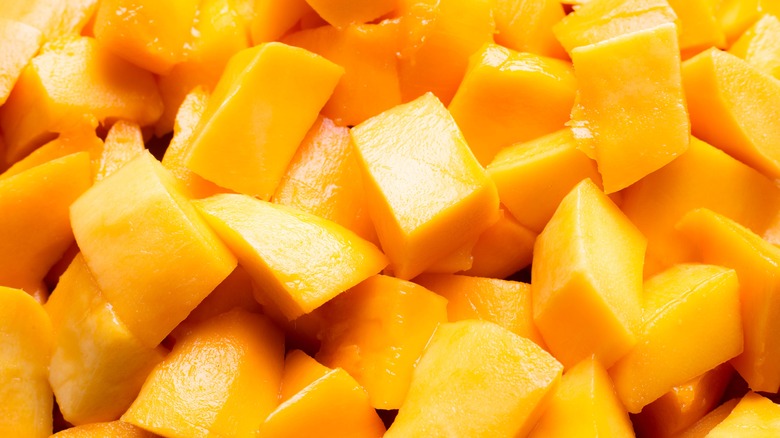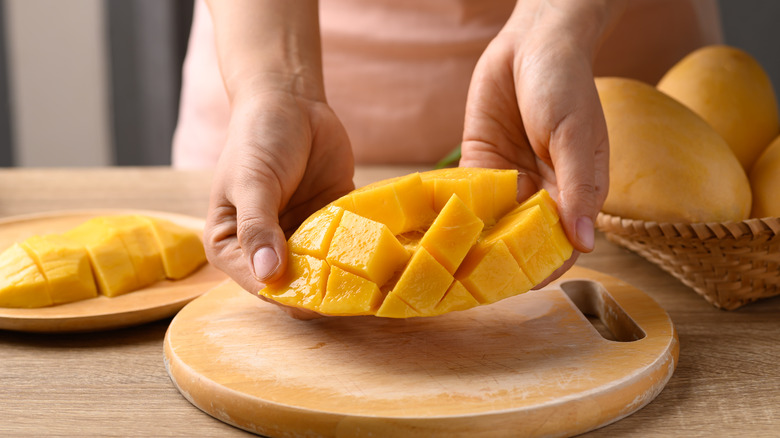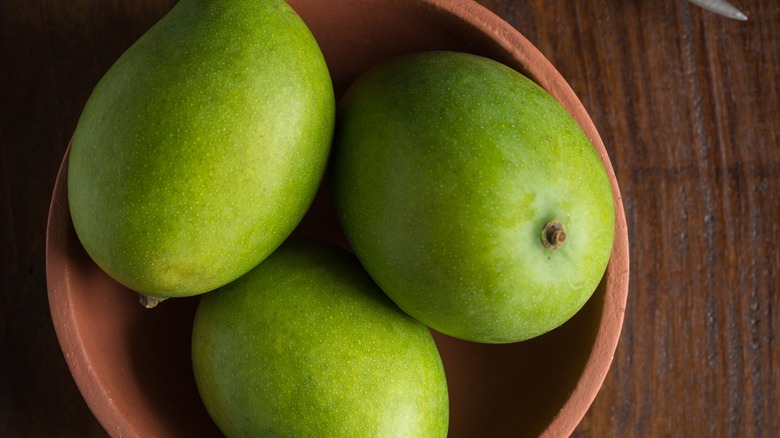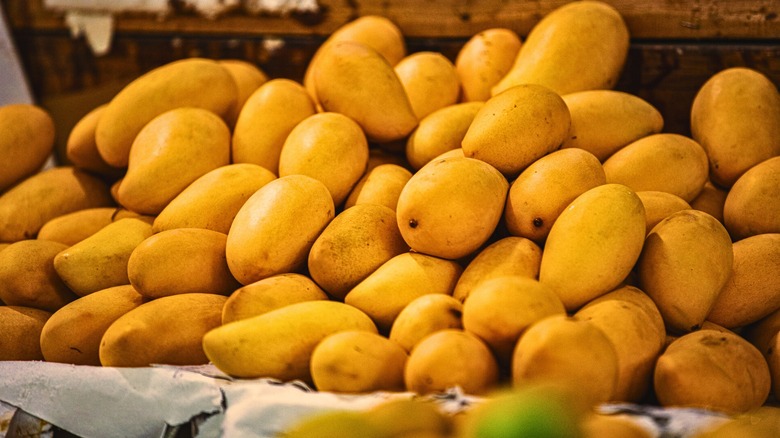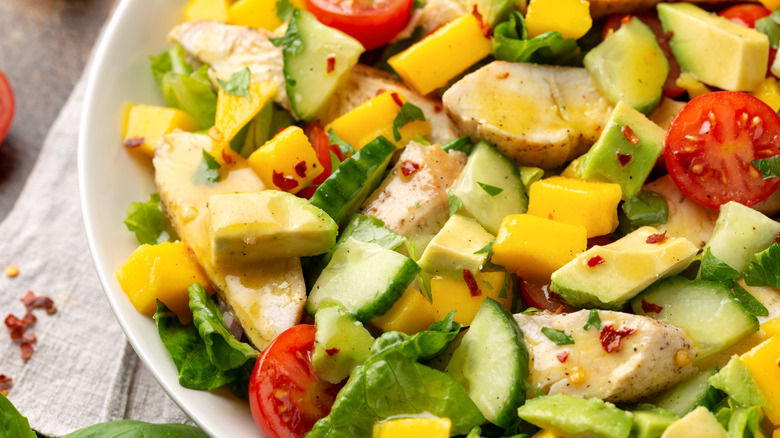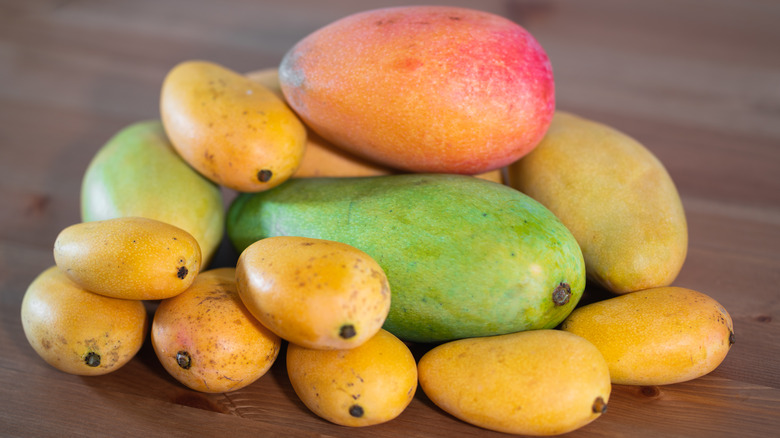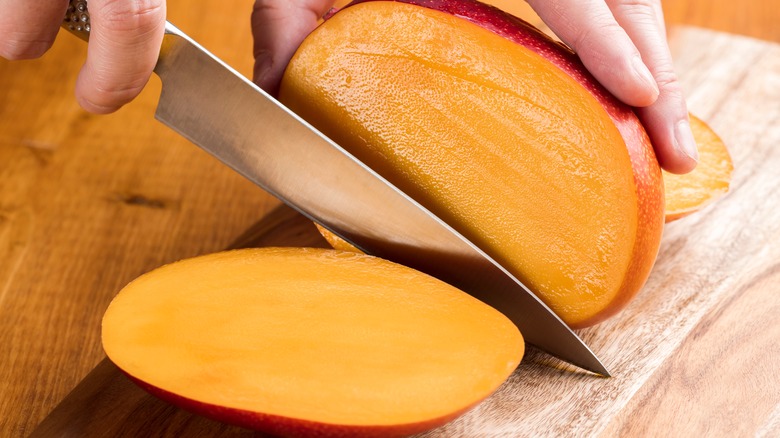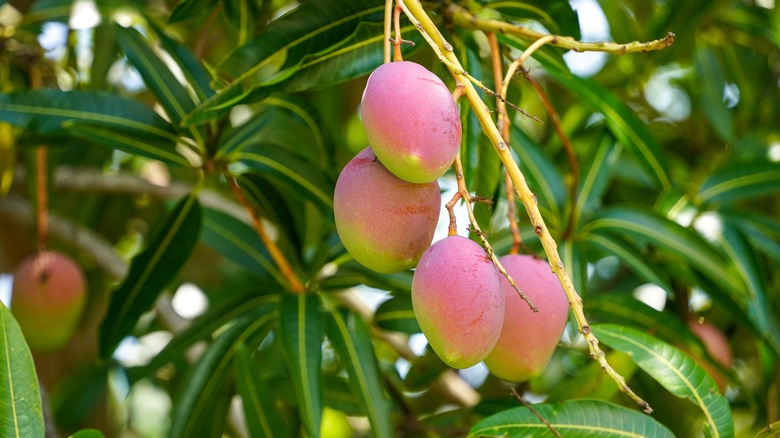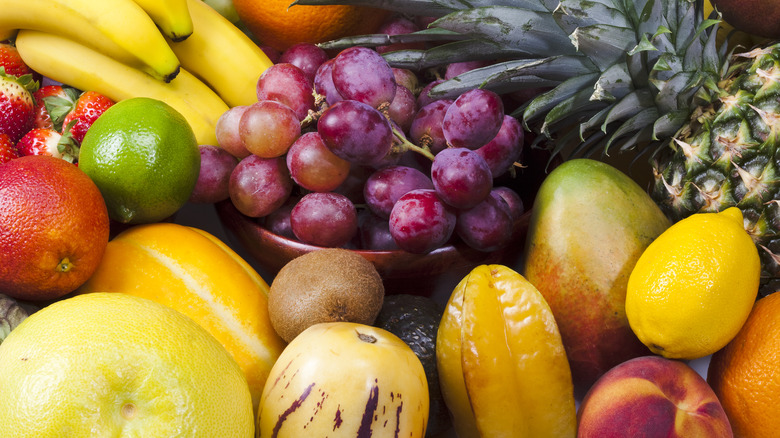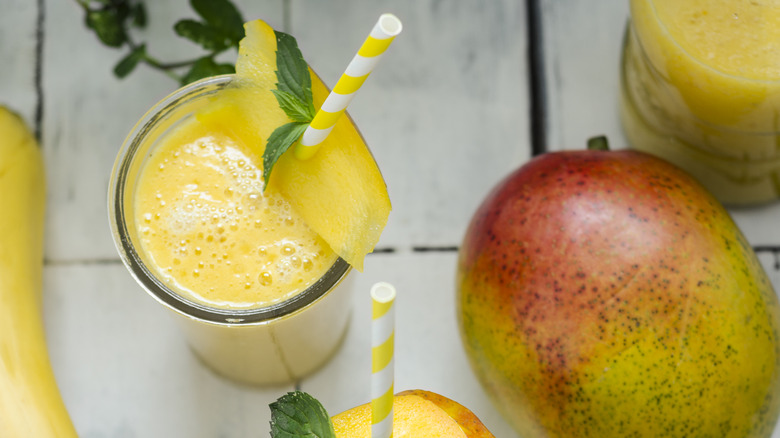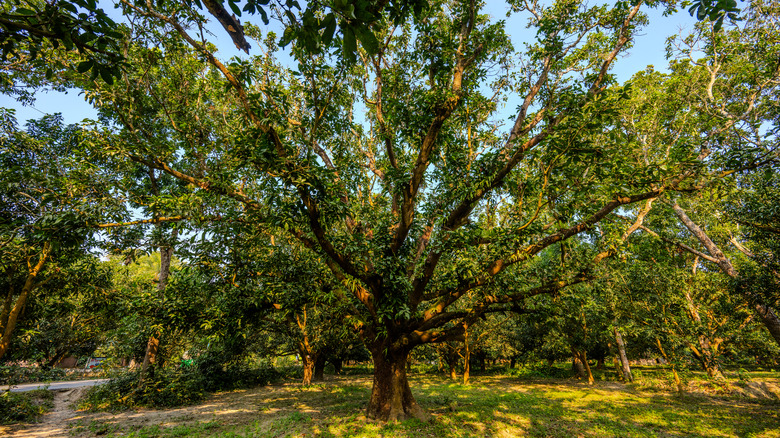False Facts About Mangos You Thought Were True
Sweet, juicy, and golden-hued, mangos are a flavorful fruit that's a favorite for many. Their unique taste and texture, along with their vibrant appearance, has led to mangos becoming a staple in diets around the world. But, when it comes to this vibrant tropical fruit, there are often some questionable "facts" thrown around, particularly relating to the various supposed impacts of eating mangos.
Thankfully, we're here to debunk the mango myths. You might have heard that these fruits are wildly unhealthy and loaded with sugar, or perhaps you've come across the idea that mangos cause acne. Maybe you've been led to believe that mangos are far too difficult to prepare, or that they're a fruit reserved for sweet recipes only. Well, we urge you to think again.
These versatile fruits deserve to be fully enjoyed and appreciated, without unnecessary worries over these unfounded claims. So, read on to discover why mangos are a nutritious, delicious, and a fascinating food, as we set the record straight on everything from how to store them to the plant family they come from.
False: Mangos are unhealthy
One of the claims about mangos we hear on repeat is that they're unhealthy due to their sugar content. While it's true that mangos have a relatively high natural sugar content in comparison to other fruits, they are also packed with an array of other beneficial nutrients.
Firstly, mangos are high in dietary fiber. Consuming fiber helps us to feel fuller for longer and keeps our digestive system functioning normally. These fruits are also high in vitamin C, with a cup of mango providing 67% of your daily recommended intake. This vitamin protects our bones and blood vessels, and is crucial for maintaining a healthy immune system. You'll also get a beneficial boost of vitamins B6, A, E, and K from consuming mango, which are all essential for various bodily functions.
Furthermore, mangos are rich in a type of antioxidant called polyphenols, which play a role in protecting the body against free radical damage and reducing the risk of developing chronic diseases. One particularly potent polyphenol that's present in mangos, called mangiferin, has been found to have anti-cancer, anti-inflammatory, and antibacterial properties (via Molecular Medicine Reports).
False: Eating them will spike your blood sugar
Another persistent myth about mangos is that they cause significant spikes in blood sugar levels due to their natural sweetness. Yes, mangos do contain natural sugars, but they do not have the same effect on blood sugar as foods with a high glycemic index.
Mangos have a glycemic index (GI) of around 51 to 56, depending on the variety and ripeness (via Medical News Today). This places them in the low to medium GI category, meaning they cause a slower and more gradual increase in blood sugar levels compared to high-GI foods like white bread or sugary snacks. This makes mangos safe to enjoy for those who are monitoring their blood sugar levels, such as people with diabetes. In fact, a 2014 study published in Nutrition and Metabolic Insights showed that eating a small amount of freeze-dried mango each day for three months led to more stable blood sugar levels among participants. Furthermore, the fiber content in mangos plays a crucial role in regulating blood sugar. Dietary fiber slows the absorption of sugar into the bloodstream, preventing any rapid spikes and keeping everything more stable.
Of course, as with any food, it's important to be mindful of portion control. Enjoying mangos in moderation, as part of a balanced diet that includes a variety of whole foods and lean proteins, is your best bet for maintaining healthy blood sugar levels.
False: Eating them will cause acne
Mangos have been criticized by some skincare enthusiasts for their supposed potential to cause acne. However, this notion is a misconception. Diet is indeed important for the health of our skin, but there is no direct evidence linking mango consumption to acne breakouts. Acne develops when hair follicles become clogged with excess sebum, bacteria, or dead skin cells, and can be triggered by hormonal changes, pollution and certain cosmetic products.
Mangos can actually be beneficial for your skin in several ways. Firstly, they are rich in vitamins A and C, both of which are crucial for maintaining healthy skin. Vitamin A helps to repair and maintain skin tissues, while Vitamin C aids in collagen production, promoting the skin's elasticity. These vitamins also have antioxidant properties, protecting the skin from free radical and sun damage.
Another skin-healthy component of mangos is their high polyphenol content. These compounds demonstrate proven anti-inflammatory properties, and since inflammation is a key factor in the development of acne, these compounds can actually help in reducing acne symptoms.
False: You should store them in the fridge
If you're popping your mangos straight into the fridge when they're fresh from the grocery store, you're doing them a disservice. The idea that mangos won't stay fresh at room temperature is incorrect. In fact, storing them outside of the fridge is essential if you want to ripen the fruit further.
Often when you pick up a mango at the store, it'll be teetering on the edge of ripeness, needing a few more days of patience before it's in its tender and juicy prime. If you put a mango in the fridge, this drastically slows down the ripening process, meaning it will take far longer to reach that perfect state. Instead, store mangos at room temperature to help speed up the process. If you have a particularly stubborn, firm mango, you can speed up ripening by placing it in a paper bag at room temperature. It should be ready to eat within a few days. Once they've reached the perfect level of ripeness, you can now transfer them to the fridge to maintain their freshness until you're ready to enjoy them — up to five days.
If you prefer to pre-slice a mango before storing, refrigeration is the way to go. Place the sliced mangos in an airtight container or plastic zip bag to prevent them from drying out or absorbing other odors from the fridge. This method will keep the cut mangos fresh for a couple of days.
False: There's only one variety of mango
Search for mangos at the grocery store, and you'll likely find just one variety. This might lead you to believe that all mangos are the same, but that would be incorrect. The distinctive red and green-skinned, oblong-shaped fruit you so frequently see is most likely the Tommy Atkins mango, but there are actually hundreds of different types of mango out there.
Almost 80% of all mangos sold in the United States are the Tommy Atkins variety. This mango is easy to transport as it has a long shelf life and doesn't bruise easily, hence its commercial popularity. The Tommy Atkins is a variety with a fairly mild flavor, characterized by its a subtle sweetness and tropical taste.
Another well-known variety is the Alphonso mango, which has a uniquely rich, creamy texture and sweet flavor. Originating from India, Alphonsos are larger in size than the Tommy Atkins variety, with skin that's vibrant yellow in color. Their incredibly tender flesh also makes these mangos highly sought after.
Dasheri mangos are another variety that's prized for deeply sweet and aromatic taste. These mangos have yellowish-green skin, that becomes more vibrantly golden as the fruit ripens. Inside, the flesh is smooth and tender, unlike the more fibrous texture of the Tommy Atkins mango.
False: They only work used in sweet recipes
With their sweet and juicy flesh, it's unsurprising that mangos have made their way into a range of delicious desserts, drinks, and bakes. Mangos make a fantastic addition to puddings, cakes, and tarts, and the famous Thai dish, mango sticky rice, is a dessert that's adored by many around the world. Despite their popularity in the creation of various sweet treats, it's a myth that mangos can't fit into savory recipes just as seamlessly. These fruits can in fact provide an amazing contrast to other rich, savory ingredients in many different dishes.
Mangos pair incredibly well with meats and seafood, such as chicken or shrimp. You can add the fruit to stir-fries and salads along with other veggies, your protein source of choice, and an aromatic sauce or dressing. The result is a well-balanced dish with the perfect combination or savory richness and tangy sweetness. And, if you love a chutney, mangos make a pretty mean one. By boiling them up with onion, garlic, ginger, vinegar, maple syrup, and spices, you can transform mangos into a flavor-packed condiment that's amazing for adding to curries or charcuterie boards.
Another mango-based creation that's perfect for enjoying alongside your dinners is mango salsa. This typically combines diced mango with tomatoes, onions, avocado, cilantro, and lime juice. Try adding the salsa to Mexican-inspired dishes like tacos, spooning it over grilled meats, or simply scooping it up onto tortilla chips for some healthy snacking.
False: They can't grow particularly large
It turns out that mangos aren't all that uniform in size. While most have a similar rounded, oblong shape, mangos can range from about six ounces to multiple kilograms in weight, depending on the specific variety and growing conditions.
One of the largest mango varieties is the Keitt mango, which has flavor notes of citrus and honey, and weighs around 12 ounces. The Palmer mango is another large fruit with a reddish-purple skin and succulent, creamy flesh. These can weigh over 17 ounces. On the other end of the scale, the Ataulfo mango is typically a smaller fruit, weighing as little as six ounces. These bright yellow mangos are incredibly sweet, with a distinct floral taste. In 2020, a couple in India set a Guinness World Record for the heaviest mango, which weighed a staggering 4.25 kilograms (9.36 pounds). Once its record status had been confirmed, the family proceeded to get stuck in and eat the enormous fruit.
The size of a mango can be influenced by various factors, including the variety, climate, soil conditions, and fertilization practices. With the right care and growing conditions, mango trees can indeed produce remarkably large fruits.
False: Cutting up a mango is difficult and wasteful
Many people shy away from mangos because they believe cutting them is a fiddly and time-consuming process. While mangos can be tricky due to their large, tough pit, with the right technique, you'll be cutting them swiftly and easily with very little wastage.
A popular and very effective mango-cutting method is the "hedgehog" technique. To do this, you'll start by standing the mango upright and slicing down each side of the pit to get two large pieces. Then, take one of the halves and score the flesh in a grid pattern, being careful not to cut through the skin. Next, press the skin side to invert the mango half, pushing the scored cubes outward. You can then easily slice off the cubes or eat them directly from the skin. For the remaining piece with the pit, peel away the skin and slice off as much flesh as possible.
Another incredibly efficient method is to peel the mango using a large drinking glass. Though it may sound dubious, this is actually one of the quickest and easiest ways to prepare the fruit. First, slice your mango on each side of the pit, as you would for the hedgehog method. Then, simply press the edge of a mango half firmly against the rim of the glass and slide down, separating the flesh from the skin. The mango flesh will fall into the glass, ready to chop into smaller pieces or enjoy as is.
False: India is the biggest exporter of mangos
Since India is the largest producer of mangos globally, with a whopping 25 million tons of mangos produced by the country in 2023, it would be easy to assume that it's also the biggest exporter of this fruit. However, this is not the case. In fact, it's actually Mexico that holds the title of the world's largest mango exporter.
Despite India producing nearly half of all mangos worldwide, much of these are consumed domestically due to the high demand for the fruit within the country itself, with fewer than 1% of mangos grown there later exported. On the other hand, Mexico has a strong export market, with Mexican mangos transported to countries such as the United States, Canada, and Japan, as well as across various parts of Europe.
It's the warm climate and nutrient-rich soil in Mexico that create the perfect conditions for mango cultivation. The fruits are typically harvested throughout spring and summer, anywhere between around March to September, though this depends on the specific type of mango. Some of the most popular varieties grown in Mexico include the Tommy Atkins, Ataulfo, Kent, and Haden mangos.
False: They're related to other common fruits
It wouldn't be illogical to assume that mangos are related to other familiar fruits — perhaps apples, oranges, or pineapples. But, mangos actually belong to a rather unique plant family, that sets them apart from many of the fruits we commonly consume.
Mangos are part of the Anacardiaceae family, which quite surprisingly, also includes cashews, pistachios, and poison ivy. This diverse family comprises over 800 species, most of which grow in tropical regions. Despite the members of Anacardiaceae being so varied, they all share one unusual characteristic. These plants produce resin, which travels through channels in the bark and turns a distinctive black color upon exposure to the air.
The fruits that plants in the Anacardiaceae family produce are typically "drupes", which have a fleshy texture and contain a single seed. And of course, mangos fit into this category. Some species of plums also sit alongside mangos in this family, such as hog plums, which have a green skin and tangy flesh, and Kaffir plums, which are bright red, and often used for making jams and jellies.
False: Overripe mangos have no use
We all know that overripe bananas are perfect for amping up the flavor in a sweet banana bread, but what use is an overripe mango? Well, it turns out that a heavily ripened mango isn't simply destined for the trash. If your fruit has been sitting on the countertop for a little too long, you can still put it to good use.
One recipe made even more delicious with the help of an overripe mango is mango bread. Like other fruit breads, this is made with a simple batter of sugar, butter, eggs, flour, and baking soda. Then, dice up the mango, toss it in a little flour to prevent it from sinking to the bottom, and fold it into the batter. This will result in a loaf that's packed with intense tropical flavor throughout.
Another excellent use for an overripe mango is blending it into a smoothie. Since the texture is likely to be a little softer, the mango will blend very easily, and its intense sweetness will add plenty of flavor. Combine the mango with other fruits, milks, or juices for a delicious and nutritious drink. If you have an excess of mangos that are a little past their prime, one top tip from Zeelicious Foods is to blitz them up into a mango purée, and transfer this to ice cube trays. Then, you can pop out individual portions of mango and add it to your smoothies as you please.
False: Mango trees are small
If you're a keen home gardener, you may have wondered whether growing mangos in your own backyard is feasible or not. After all, many fruits, like lemons and blueberries, grow on small, shrubby trees or bushes that are easy to plant in a container. However, when it comes to mangos, cultivating your own requires rather a lot more space.
Mango trees can grow to impressive heights and widths, and if planted in your garden, it would become a pretty substantial fixture. When grown in optimal conditions, the trees can reach heights of up to 100 feet and have a canopy that spreads 35 feet wide. The size of a mango tree will depend on its variety and the environment it's grown in. Mangos thrive in a warm, tropical climate, requiring plenty of sunlight. They also prefer well-draining, nutrient rich soil.
To manage their size, mango trees can be pruned regularly. Removing any dead branches will make it easier to harvest the fruit and helps to keep the tree in check if it's growing in a smaller space. Pruning also encourages better air circulation and sunlight penetration, promoting healthier growth and hopefully a more abundant crop of fresh, juicy mangos!
